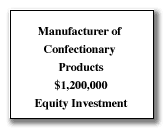|
Financing Challenge:
 A $7 million confectionary Company that sells licensed products to retail chain stores throughout the United States experienced a major setback. A $7 million confectionary Company that sells licensed products to retail chain stores throughout the United States experienced a major setback.
The Company imported the majority of its food product from China. In early 2007, chemicals manufactured in China used to make pet food in the United States as well as baby formula produced in China for Chinese consumption were found to contain a chemical called Melamine which was used as a substitute for protein. In the United States, this chemical was found to cause the death of many dogs and cats and resulted in a massive pet food recall. In 2008, baby formula produced in China caused the sickness of more than 1,000 babies in China.
These scandals caused retailers and consumers to resist buying food products produced in China even if testing showed virtually no Melamine content.
Many of the Company's customers stopped purchasing the food products that were imported from China. One of the Company's largest licensors requested that the Company pull product off retail shelves throughout the United States that had its cartoon characters imprinted on it. This action would have cost the Company over $3 million and would have put it out of business. The Company refused and the licensor pulled its license. Loss of this major license and lost sales due to customers not buying food products imported from China devastated the Company resulting in a loss of $1.1 million in 2008 compared to a profit of $310,000 in 2007.
The Company had a line of credit with a commercial bank with loan availability determined by a monthly borrowing base. The Company's loan availability was based on the level of accounts receivable and inventory. As the Company was well managed and a long-time customer of the bank, the bank issued the Company an additional term loan at the start of the Melamine scare to help the Company get through this crisis. The line of credit and term loan totaled $1,200,000. However, neither the bank nor the Company ever expected the crisis to have such a devastating affect on the Company.
In July 2009, the bank was under-collateralized by $900,000 as loan availability per the borrowing base was only $300,000 and the loan balance was $1,200,000.
The bank had personal guarantees from the Company's principals who had the vast majority of their personal net worth tied up in their homes. The principals were adamant about not using the equity in their homes to satisfy their business obligations.
On a positive note, many of the Company's existing and prospective customers indicated they would purchase food products if they were produced in the United States. To manufacture product locally, the Company needed to purchase production equipment, raw materials, packaging and train a new production staff.
The bank referred the Company to Asset Enhancement Solutions, LLC for assistance.
Creative Financing Solution:
Asset Enhancement Solutions, LLC ("AES") recognized that with large losses in 2008 and 2009 and a senior lender that was significantly under-collateralized, it would be very difficult for the Company to obtain alternative debt financing.
To attract an equity investor the Company had to tell its story, its history and future in a very compelling and professional manner.
AES prepared a comprehensive Business Plan that discussed the Company's turnaround plan and supported it with extensive, detailed projections that demonstrated the feasibility, cost and timing of transitioning to product manufactured locally by the Company. AES also assisted the Company prepare an elaborate Power Point Presentation to present to prospective investors.
AES identified different types of potential investors and contacted the investors on behalf of the Company. AES received interest from both a Private Equity Group and a Strategic Investor. AES and the Company met with these potential investors on several occasions. AES assisted the Company in reviewing and negotiating the Letters of Intent and identifying the pros and cons of each investor.
The Principals made the decision to accept the investment from the Strategic Investor as they felt it offered them better opportunities for the future.
The Strategic Investor made an equity investment of $1.2 million in the Company, $800,000 in cash and $400,000 in the assumption of outstanding bank debt. The Principals' goal of preserving the equity in their personal residences was achieved.
The bank was very satisfied. Their loan was paid down by $400,000 and they now had a new $400,000 guarantee from a healthy company. The investment from the Strategic Investor fueled the successful execution of the Company's turnaround plan and at the end of January 2010 its borrowing base supported a loan availability of over $1 million. The bank was no longer under-collateralized.
To the bank's surprise, the Strategic Investor approached the bank for purposes of recapitalizing its own balance sheet. Thus, the bank went from being under-collateralized by $900,000 to having the opportunity to propose on an additional $6 million credit facility.
It turned out to be a Win-Win situation for all parties involved.
Contact
Neil Seiden, 516-767-0100
neil.seiden@assetenhancement.com
<< Back to index
| 
